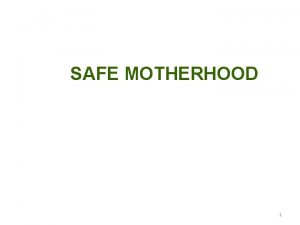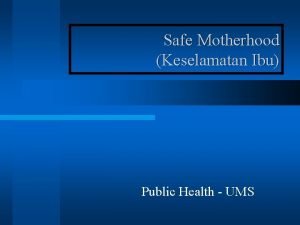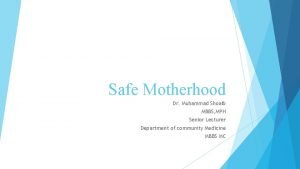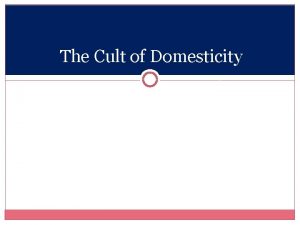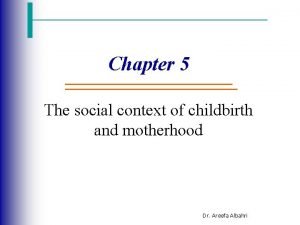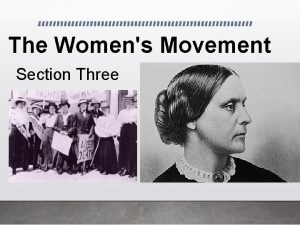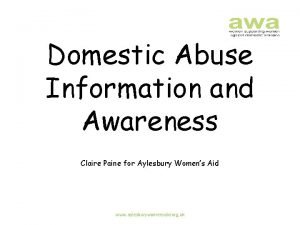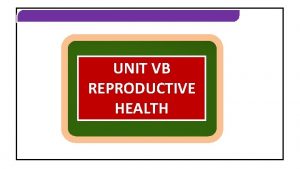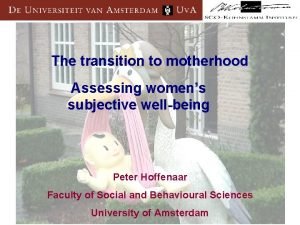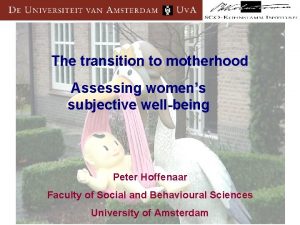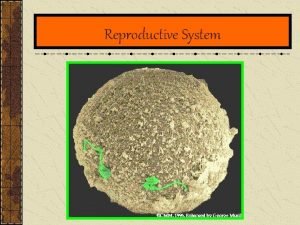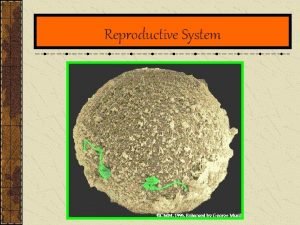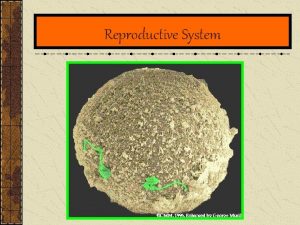Reproductive Health class2 Safe motherhood Womens Health Key




















- Slides: 20

Reproductive Health class#2 Safe motherhood

Women’s Health Key facts

§ Worldwide, women live an average four years longer than men. § In 2011, women's life expectancy at birth was more than 80 years in 46 countries, but only 58 years in the WHO African Region. § Girls are far more likely than boys to suffer sexual abuse. § Road traffic injuries are the leading cause of death among adolescent girls in high- and upper-middle-income countries. § Almost all (99%) of the approximate 287 000 maternal deaths every year occur in developing countries. § Globally, cardiovascular disease, often thought to be a "male" problem, is the number one killer of women. § Breast cancer is the leading cancer killer among women aged 20– 59 years worldwide. http: //www. who. int/mediacentre/factsheets/fs 334/en/

§ Globally, 287 000 pregnancy-related deaths occur every year, 99% of which are in developing countries. § Maternal deaths are the second biggest killer of women of reproductive age. § There is a broad range of direct and indirect efforts to reduce deaths and disabilities resulting from pregnancy and childbirth.

§ In 1987 the World Bank, in collaboration with WHO and UNFPA, launch of the Safe Motherhood Initiative (SMI). § Safe motherhood means ensuring that all women receive the care they need to be safe and healthy throughout pregnancy and childbirth § SMI sets its aim to reduce maternal mortality and morbidity by one half by the year 2000 § Inter-Agency Group (IAG) for Safe Motherhood established Pillars of Safe Motherhood

Pillars of Safe Motherhood Caption

Pillars of Safe Motherhood Caption

Safe motherhood initiatives, are they cost-effective? Subtitle

§ Unwanted or unplanned pregnancies cause emotional and economic hardship not only to women but also to their families. § Children whose mothers die or are disabled in childbearing have drastically diminished prospects of leading a productive life. § The burden on women associated with frequent pregnancies, poor maternal health, pregnancy complications, and caring for sick children contributes to their poverty “Safe motherhood is an important social and economic investment. It is a matter of social justice and human rights. ”

Medical factors Socioeconomic and cultural factors that consider “women are a socially disadvantaged group” Keep in mind that maternal mortality is not merely a “health disadvantage”—it is also a “social disadvantage” (WHO 1986). What are the determinants of maternal mortality and morbidity? Caption

Strategies for Prevention of Maternal Mortality pillars of safe motherhood 1. Antenatal Care: Effective antenatal care is essential to detect preexisting conditions, prevent complications where possible, and ensure that complications of pregnancy are detected early and treated appropriately. 2. Clean and Safe Delivery: All birth attendants must have the knowledge, skills, and equipment to perform a clean and safe delivery and provide postpartum care to mother and baby pregnancies.

§ 3. Essential Obstetric Care: Pregnancy is a period of potential risk, and any pregnant woman can develop complications. Therefore, interventions are needed at a community level and also within health services to ensure that essential care for high -risk pregnancies and complications is made available to all women who need it. 4. Family Planning: Individuals and couples must have the information and services to plan the timing, number, and spacing of pregnancies, and to prevent unwanted

Making motherhood safe requires action on: § Reducing the numbers of high-risk and unwanted pregnancies Requirement: All women have access to contraception to avoid unintended pregnancies § Reducing the numbers of obstetric complications All pregnant women have access to skilled care at the time of birth § Reducing the case fatality rate in women with complications All women with complications have timely access to quality emergency obstetric care

Effective Strategies to Achieve Safe Motherhood § Focused Antenatal Care § Minimizing Delays § Skilled Attendant at Birth § Pregnancy Spacing

Antenatal care helps women maintain normal pregnancies through focused assistance and individualized care. § The WHO model of antenatal care recommends 4 -5 focused antenatal care visits for women not having problems or complications. § Antenatal care aims to: –Detect and treat existing conditions or complications –Prevent complications and disease –Prepare for the birth and be ready for complications –Include health promotion education

Minimizing Delays § Delays leading to maternal death are often multi-factorial. § Three Delays Model § Delay in decision to seek care can be influenced by: § Failure to recognize complications § Societal acceptance of pregnancy risk/maternal death § Low status of women § Socio-cultural barriers to seeking care

§ Delay in reaching care can be influenced by: § Poor referral organization and lack of transport § Delay in obtaining care at a facility can be influenced by: § Inadequate facilities, supplies, personnel § Poor training/ lack of motivation of personnel § Lack of finances

Skilled Attendant at Birth § The presence of a skilled attendant at delivery is a leading predictor of a safe delivery.

Pregnancy Spacing § Timing of pregnancy and intervals between pregnancies are strongly related to personal preference and social custom. § Age, family desires, family supports, economic and social circumstances, and access to health care may all play a role in birth spacing. § The recommended birth spacing is: § At least 2 years after a live birth § At least 6 month after a miscarriage or induced abortion § Intervals <6 months pose an increased risk of maternal mortality, intervals >5 years increase the risk of pre-eclampsia in the mother, preterm birth, low birth weight and small for gestational age growth problems in the infant.

References § www. safemotherhood. org § http: //web. worldbank. org/WBSITE/EXTERNAL/TOPICS/EXTHEALTHNUTRITI ONANDPOPULATION/EXTPRH/0, , content. MDK: 20200213~menu. PK: 548457~ page. PK: 148956~pi. PK: 216618~the. Site. PK: 376855, 00. html § Women and Health Learning Package: Safe Motherhood: www. the. Networktufh. org
 Pengertian safe motherhood
Pengertian safe motherhood Pilar safe motherhood
Pilar safe motherhood Logo safe motherhood
Logo safe motherhood Pillars of safe motherhood
Pillars of safe motherhood Republican motherhood
Republican motherhood Cult of domesticity republican motherhood
Cult of domesticity republican motherhood Republican motherhood
Republican motherhood Republican motherhood vs cult of domesticity
Republican motherhood vs cult of domesticity Social context of childbirth and motherhood
Social context of childbirth and motherhood Safe feed safe food
Safe feed safe food Safe people safe places
Safe people safe places Needs of adolescence
Needs of adolescence Womens rights
Womens rights Late night womens hour
Late night womens hour Claire paine
Claire paine Womens right
Womens right Differences between men's and women's soccer
Differences between men's and women's soccer Womens college kumbakonam
Womens college kumbakonam Womens college kumbakonam
Womens college kumbakonam Womens right
Womens right Womens shelter edmonton
Womens shelter edmonton
